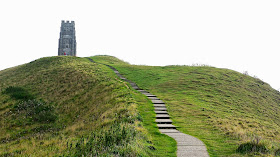 |
| The Church of St John the Baptist, Glastonbury. In the churchyard is a thorn tree grown from a cutting from the Glastonbury Thorn. A blossom from this tree is sent to the Queen every Christmas. |
I'm very much enjoying Martin and Nigel Palmer's Sacred Britain: A Guide to the Sacred Sites and Pilgrim Routes of England, Scotland and Wales. The scope of the book is dizzying; it's astonishing how much ritual and religious history overlays the landscape of this small island. The pilgrim routes described take you to Neolithic henges and long barrows, Bronze Age burial mounds and Iron Age hill forts, Celtic groves and holy wells, early Saxon churches and Viking crosses. Though the routes are aimed at the motorist, it would be fun to trace alternative, more authentic ways along ancient paths and tracks.
 |
| One of the paths up Glastonbury Tor. |
The Palmers' sympathies lie with pre-Synod of Whitby Celtic Christianity rather than the Romanised version, which is where my own sympathies lie too. They are good at showing how cultures clash but eventually integrate, and how paganism and Christianity intermingle (it's well known, for example, that our word for 'Easter' derives from the Germanic pagan goddess, 'Eostre').
 |
| View from the Tor: the ethereal Vale of Avalon. |
All this brought back to mind last year's visit to Glastonbury: the British epicentre of Christian myth, Celtic lore and pagan legend.
 |
| The tower of St Michael's Church on Glastonbury Tor. |
One story goes that Joseph of Arimathea, a wealthy trader and Jesus' uncle, came to Glastonbury and built a church there (on the site of the present abbey ruins) made of wattle — thus creating the first Christian community in Britain. He was also supposed to have carried with him the Holy Grail, the cup used by Christ at the Last Supper and containing some of Christ's blood. This was hidden by Joseph of Arimathea in the Chalice Well Gardens and later discovered by King Arthur's Knights of the Round Table — giving rise to the Arthurian Grail legends.
 |
| Red Spring waters flow through the Chalice Well Gardens. |
The Palmers' view of Glastonbury . . .
Today Glastonbury remains its enigmatic self. Here you can find the highest concentration of religious nonsense and spiritual tat in Britain. But you can also find people who are working to make sense of an insensitive world, who find here a place of great spiritual power and who have helped us rediscover the sacredness of this landscape — sacredness which is actually a quintessential fusion between the old Celtic and earliest Christian traditions.
. . . recalled my own feelings about the town . . .
In the middle of September we spent a long weekend in Glastonbury. Yes, between festivals Glastonbury town is alive, well and gently stoned: it's a haven for spiritual seekers and old hippies at any time of year. I liked it a lot but, amid the welter of New Age flummery and soul chic, found it hard to distinguish between the real and the sham, the true and the fake, the non-material and the commercial.
 |
| Shrine in the Chalice Well Gardens. |
What a gorgeous and deeply archetypal place. I've always wanted to visit, so thank you for this stunning virtual tour.
ReplyDeleteVery beautiful. I'm not religious, but do enjoy hearing about the history of place and wonder about faith and what drives men to create such places.
ReplyDeleteThanks for these comments, Amanda and Donna. I'm pleased you enjoyed the post.
ReplyDelete